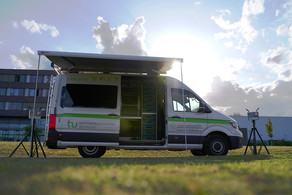Master Student Project Group SWIFTdrive (co-Simulated Wirelessly Integrated Framework for Teleoperated driving) successfully completed
- Project Group

Motivated by the need for safer and more efficient testing environments for teleoperated and autonomous networked driving systems, the SWIFTdrive project group developed an integrated framework combining scaled real-world robotics with advanced digital twin simulations. This approach reduces costs and risks associated with full-scale testing while enabling robust evaluation of teleoperation, including the early assessment of 6G research concepts and recent proposals from the international research community.
Two core goals were addressed to achieve this: First, scaled-down robotic platforms based on the F1TENTH system were designed and equipped with modular hardware, including 3D-printed mounts, various sensors, AI processors, and communication hardware. These platforms facilitate safe and controlled testing of teleoperated driving and sensor integration. Second, a co-simulated digital twin environment was created to evaluate future 6G technology approaches like Reflective Intelligent Surfaces (RISs) and the resulting communication performance. That way, students got in touch with cutting-edge 6G research conducted at the chair. This digital twin supports real-time testing by emulating constrained communication characteristics and optimizing system responses to varying network conditions. Furthermore, Augmented Reality (AR) glasses were effectively used to mirror the partial simulation in the real world.
The group also implemented advanced features such as containerized software for rapid reconfiguration and deployment, a monitoring dashboard for real-time system diagnostics, and a Model Predictive Control (MPC)-based platooning algorithm to enable precise and scalable vehicle coordination. The created SWIFTdrive framework demonstrates the potential of combining physical and virtual systems to not only innovate mixed teleoperated and automated driving technologies but also integrate recent advancements in 6G research, ensuring safe and efficient system development for real-world vehicular applications based on the ongoing research on wireless communications.
Further information:
Chair: Communication Networks Insitute (CNI)
Supervisors: Niklas Wagner, Hendrik Schippers, Karsten Heimann
Start date: April 2025
Please confirm video activation.
After activation, cookies will be set and data is sent to YouTube (Google).
To the Google Privacy Policy






